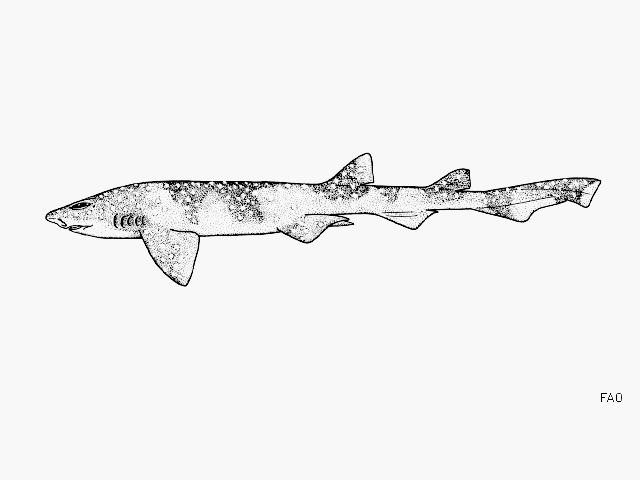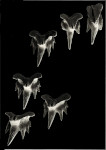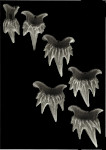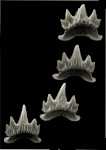Scyliorhinus capensis
(Müller & Henle, 1838)
Yellowspotted catshark
Classification: Elasmobranchii Carcharhiniformes Scyliorhinidae
Reference of the original description
Systematische Beschreibung der Plagiostomen. Berlin, Veit, pp. 1–200
Systematische Beschreibung der Plagiostomen. Berlin, Veit, pp. 1–200
Image of the original description
No image in first description.
No image in first description.
Synonyms / new combinations and misspellings
Catulus capensis, Scyliorhinus (Scyliorhinus) capense, Scyliorhinus (Scyliorhinus) capensis, Scylliorhinus capensis, Scyllium capense
Catulus capensis, Scyliorhinus (Scyliorhinus) capense, Scyliorhinus (Scyliorhinus) capensis, Scylliorhinus capensis, Scyllium capense
Types
Scyliorhinus capensis
Syntype: BMNH: 1953.5.10.3 RMNH: incat. (whereabouts unknown) Lectotype: BMNH: 1845.7.3.141; Paralectotype: BMNH: 1845.7.3.144; BMNH: 1953.5.10.2;
Scyliorhinus capensis
Syntype: BMNH: 1953.5.10.3 RMNH: incat. (whereabouts unknown) Lectotype: BMNH: 1845.7.3.141; Paralectotype: BMNH: 1845.7.3.144; BMNH: 1953.5.10.2;
Description :
Citation: Scyliorhinus capensis (Müller & Henle, 1838): In: Database of modern sharks, rays and chimaeras, www.shark-references.com, World Wide Web electronic publication, Version 12/2025
Please send your images of "Scyliorhinus capensis" to info@shark-references.com

Scyliorhinus capensis (Müller & Henle, 1838), © FAO, www.fish-base.org

Scyliorhinus capensis (Müller & Henle, 1838), © FAO, www.fish-base.org
Common names
 Alitán de manchas amarillas,
Alitán de manchas amarillas,  Roussette à taches jaunes,
Roussette à taches jaunes,  Yellow-spotted cat shark,
Yellow-spotted cat shark,  Yellowspotted catshark
Yellowspotted catshark
 Alitán de manchas amarillas,
Alitán de manchas amarillas,  Roussette à taches jaunes,
Roussette à taches jaunes,  Yellow-spotted cat shark,
Yellow-spotted cat shark,  Yellowspotted catshark
Yellowspotted catshark
Short Description
Diagnosis after Compagno, 1984 [517]: Field Marks : A fairly large and slender, bright yellow-spotted and grey-saddled catshark with small anterior nasal flaps that do not reach mouth, no nasoral grooves, labial furrows on lower jaw only, second dorsal fin much smaller than first. Diagnostic Features: Head and body relatively deep, slender and narrow; greatest width of head less than 2/3 of head length; no nasoral grooves; anterior nasal flaps not expanded and falling just short of mouth. First dorsal origin somewhat behind pelvic insertions; second dorsal origin over pelvic insertions; interdorsal space somewhat greater than anal base. Denticles fairly large and erect, skin relatively rough. Colour pattern of numerous small bright yellow spots about size of eye pupil or more; 8 or 9 dusky grey saddle marks on back; no dark spots. Size large, to 1.2 m.
Diagnosis after Compagno, 1984 [517]: Field Marks : A fairly large and slender, bright yellow-spotted and grey-saddled catshark with small anterior nasal flaps that do not reach mouth, no nasoral grooves, labial furrows on lower jaw only, second dorsal fin much smaller than first. Diagnostic Features: Head and body relatively deep, slender and narrow; greatest width of head less than 2/3 of head length; no nasoral grooves; anterior nasal flaps not expanded and falling just short of mouth. First dorsal origin somewhat behind pelvic insertions; second dorsal origin over pelvic insertions; interdorsal space somewhat greater than anal base. Denticles fairly large and erect, skin relatively rough. Colour pattern of numerous small bright yellow spots about size of eye pupil or more; 8 or 9 dusky grey saddle marks on back; no dark spots. Size large, to 1.2 m.
Distribution
Karas region of southern Namibia, occurring off the Cape of Good Hope, and to Waterloo Bay, King William’s Town, in the Eastern Cape [27296] Source: www.gbif.org
Karas region of southern Namibia, occurring off the Cape of Good Hope, and to Waterloo Bay, King William’s Town, in the Eastern Cape [27296] Source: www.gbif.org
Human uses
fisheries: of no interest; gamefish: yes
fisheries: of no interest; gamefish: yes
Biology
Oviparous, with a single egg per oviduct at a time [517]. Oviparous, paired eggs are laid. Embryos feed solely on yolk [733]. Size upon hatching below 31 cm (size of young with umbilical scars) [517]. Feeds on fish, cephalopods and crustaceans [536].
Oviparous, with a single egg per oviduct at a time [517]. Oviparous, paired eggs are laid. Embryos feed solely on yolk [733]. Size upon hatching below 31 cm (size of young with umbilical scars) [517]. Feeds on fish, cephalopods and crustaceans [536].
Dentition
Monognathic heterodonty gradual well developed; anterior teeth abruptly larger than the parasymphysial ones and lateral teeth smaller distally, with smaller and thicker principal cusps. Sexual heterodonty present with females presenting anterior teeth with more developed cusplets and shorter principal cusps in relation to males (Figs. 23, 24). Tooth counts 24–38 26–38/22–41 23–40. Parasymphysial teeth with a principal cusp flanked by one cusplet on each side; proximal cusplets 2/3 the height of the principal cusp and marginal ones poorly developed. Protuberances on the crown base or striae inconspicuous. Anterior teeth larger than the parasymphysial and principal cusp less stout. Anterior teeth with two cusplets; principal cusp greater and more slender than parasymphysial teeth. Anterior upper teeth with protuberances in crown base and striae extending through 1/3 the height of the principal cusp; striae absent in lower teeth. Females with anterior teeth with cusplets distally sharp and more developed than in males, corresponding to half the height of the principal cusp. Lateral teeth with four cusplets; marginal cusplets as high as proximal ones. Principal cusp slightly oblique in both jaws, proximal cusplets 2/3 the height and half the width of principal cusp. Protuberances present in crown base and striae extending throughout the crown. Commissural upper teeth with two or three cusplets; principal cusp stronger and slightly oblique and cusplets corresponding to more than half the height of principal cusp. Marginal cusplets, when present, poorly developed. Protuberances present and striae extending slightly more than half the height of the principal cusp. Ectodermal pits present in lateral and commissural teeth, restricted to the crown base. [27296]
Monognathic heterodonty gradual well developed; anterior teeth abruptly larger than the parasymphysial ones and lateral teeth smaller distally, with smaller and thicker principal cusps. Sexual heterodonty present with females presenting anterior teeth with more developed cusplets and shorter principal cusps in relation to males (Figs. 23, 24). Tooth counts 24–38 26–38/22–41 23–40. Parasymphysial teeth with a principal cusp flanked by one cusplet on each side; proximal cusplets 2/3 the height of the principal cusp and marginal ones poorly developed. Protuberances on the crown base or striae inconspicuous. Anterior teeth larger than the parasymphysial and principal cusp less stout. Anterior teeth with two cusplets; principal cusp greater and more slender than parasymphysial teeth. Anterior upper teeth with protuberances in crown base and striae extending through 1/3 the height of the principal cusp; striae absent in lower teeth. Females with anterior teeth with cusplets distally sharp and more developed than in males, corresponding to half the height of the principal cusp. Lateral teeth with four cusplets; marginal cusplets as high as proximal ones. Principal cusp slightly oblique in both jaws, proximal cusplets 2/3 the height and half the width of principal cusp. Protuberances present in crown base and striae extending throughout the crown. Commissural upper teeth with two or three cusplets; principal cusp stronger and slightly oblique and cusplets corresponding to more than half the height of principal cusp. Marginal cusplets, when present, poorly developed. Protuberances present and striae extending slightly more than half the height of the principal cusp. Ectodermal pits present in lateral and commissural teeth, restricted to the crown base. [27296]
Remarks
shark-references Species-ID=6300;
shark-references Species-ID=6300;






















